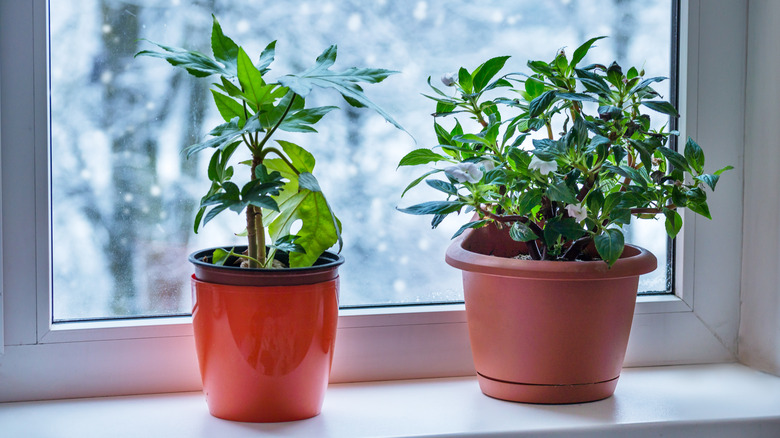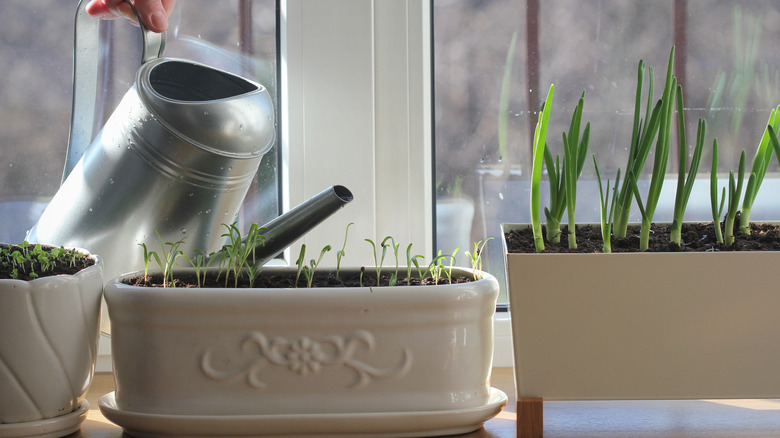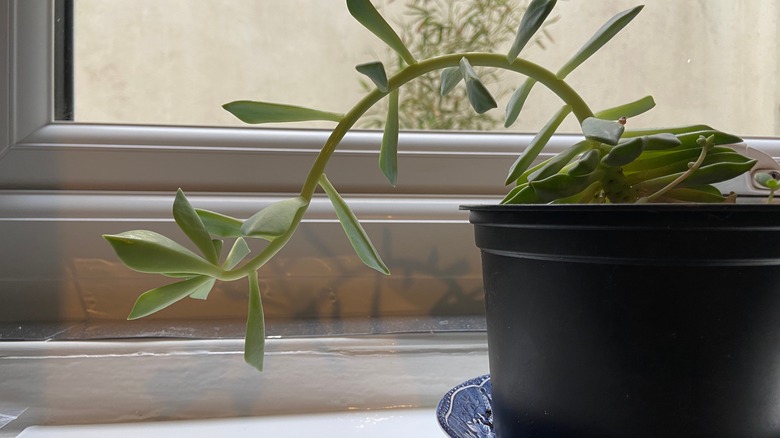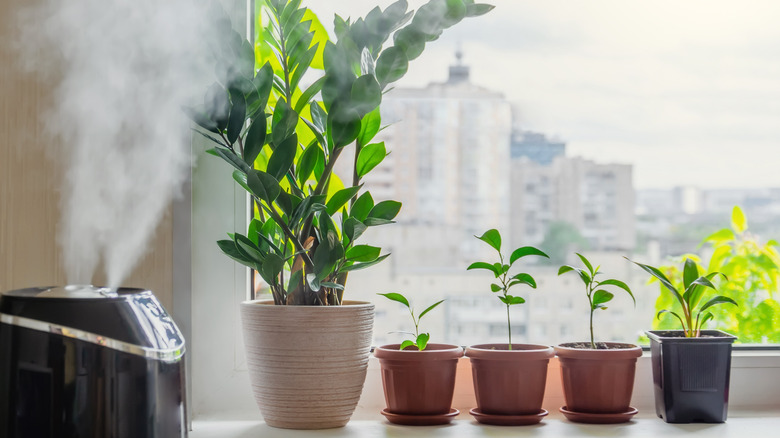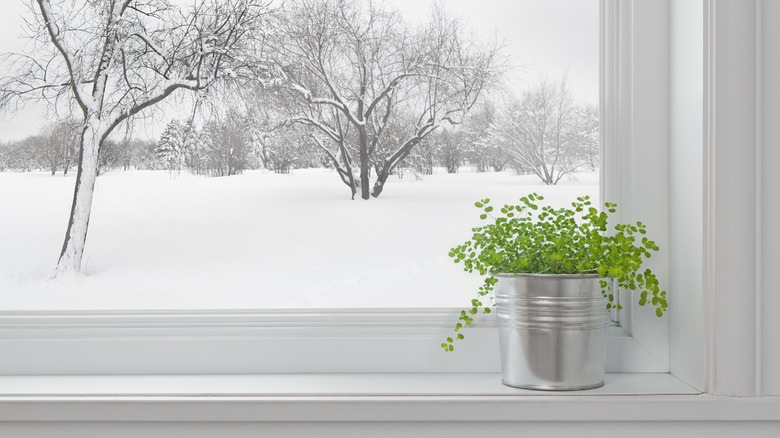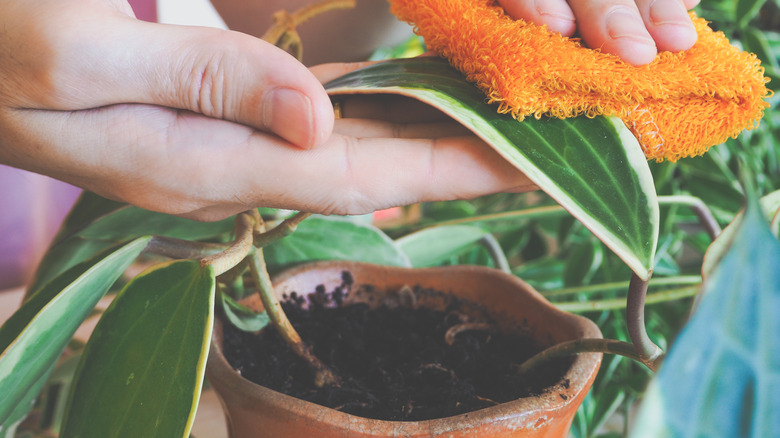5 Novice Houseplant Pitfalls To Avoid This Winter
Winter houseplants are a little like Goldilocks and the Three Bears fairytale but less easy to read. An indoor plant likes it not too hot but also not too drafty. Too watery is bad but too dry is a problem as well. For those of us who are mere novices at gardening, the counterintuitive rules it takes to keep winter houseplants alive can have us feeling like we might as well cut our losses and start fresh next summer.
However, stakes are high around the home these days. According to the National Institute of Mental Health, this time of year is tough on families' well-being; the seasonal depression that seeps into our residences when the weather gets cold and mornings get dark is no joke.
According to a Kansas State University study reported by Red, data shows diminished sickness rates and less fatigue thanks to plants in your office or home, so, sleeves up, novices! If we keep our eye on consistent, small steps and resist panicking at the first sign of a droopy leaf here and there, we might charm our indoor cultivars all the way into actually thriving this winter. Also, we can have each other's back by rallying around an age-old mantra dug up from garden archives of yore that goes something like this: those who can't, borrow. So, here are a few cheat sheets with borrowed notes to help us through the houseplant challenge this winter.
1. Too much water leads to rot
Since we drill extra hydrating habits into our personal routines all winter long, we think indoor winter plants need extra moisture too. That's a mistake. According to BioAdvanced, plant growth slows significantly, down to dormancy for some plants during the cold months, so dry topsoil is not the sign to water like it is in the summer. However, plant roots still need a drink, so once the soil is dry down maybe 2 inches, it's time to water, but until then, cut back. You can judge this by digging a finger into your pot several inches to check for moisture. Another idea is to lift your pot — dry soil is lighter, and you may begin to get a feel for when your plant needs water.
Plants that are watered weekly during active growth seasons need as little as twice a month through the winter season. If that has you feeling negligent, think again. As Stylist notes, over-hydrating plants in the winter waterlogs the roots, cuts their oxygen supply, and can cause root rot. Some exceptions to the less-is-more water rule in winter are ferns, which require regular drinks, and certain succulents, like the mini rose succulent, which is dormant in summer, not colder months. Otherwise, less liquid all around and steer clear of fertilizing altogether until spring. Watch for mushy, yellow leaves as a telltale warning that you're overwatering.
2. Not enough light leaves plants leggy and lacking
While your plant likely goes dormant in winter months, its basic photosynthesis needs do not. So droopy cultivars that you might suspect need a water adjustment could simply need more sun. If the look of the leaves changes, your plant may tell you that it needs more natural light, says Houseplant Help. Variegated leaves turn solid green, for instance, or sprouts that are especially little or a paler green than usual (a sign your plant isn't producing its normal boost of chlorophyll). In addition, wider spaces between leaf nodes on your stem (called an internode) can appear. Your plant might also begin dropping leaves to save energy just to sustain itself.
However, the most telltale sign of lack of sun is your plant's stem starts looking oddly overextended, thin, and as if it is reaching or leaning toward any light it can find. This is the best time to take action, but don't worry — you can turn the situation around, Houseplant Help says. For example, if your plant has been next to an east-facing window but needs more light, you can simply reposition that pot by a south-facing window. Proceed systematically. Shoving your plant into the sun inattentively can singe its leaves if the light shift is too dramatic, so change its position little by little. One way to ease it into a new window setting is to turn it regularly, so all sides receive an even sunbath rather than a sunburn.
3. Extra humidity? Yes, please, but spritz with caution
We heat our winter rooms to make them toasty warm for us, but that poses a problem for our indoor plants. The hot, dry air blowing around the house is the furthest thing from most houseplants' ancestral environments. Instead, they most often originate from forests or thickets with moisture hanging in the air thanks to evapotranspiration — the process of plants absorbing water from the soil, passing it through stems and leaves, and then evaporating out into the atmosphere from there (via Healthline).
Extra humidity may be in order if you spot a browning fringe on your houseplant leaves. However, a few tools and strategic steps can save the day. Joy Us Garden suggests bundling your houseplants and placing them on the bathroom counter once a month while you shower. Another idea is using a spray bottle to mist the air (not the leaves) around your plants a few times a week. Misting the leaves for the purpose of hydration may seem nice, but the effect is temporary, and there is a possibility that leaves hold mini pools of water, which makes them vulnerable to diseases and brown spots.
You might also try a small humidifier or simply place your potted plant on a tray that is filled with stones and water. The water will slowly evaporate from the tray, emitting moisture into the surrounding air. Be sure to use large enough stones so the bottom of the pot stays completely dry.
4. Nobody likes a draft – least of all winter houseplants
Winter houseplants are particularly noncommittal. Thanks to the extra sun that they leaned and reached for starting first thing in the morning, by dusk, those windows that they loved all day give them a chill. By nightfall, your plants would like to get away from that drafty pane altogether.
Closing your window curtains at night could help the situation and curb the chill from the draft, says Plant Perfect, but you may also need to move your plant away from the area altogether at night as the temperature drops. Even electrical outlets that have negligible winter drafts that you wouldn't have considered problematic under other circumstances could chafe your indoor cultivars in ways you hadn't expected.
Keep in mind that too warm isn't ideal either. Plants cannot be situated too close to that fireplace that you now run all winter long to warm your evenings. Too close to a heating vent is a problem too. You'll notice your plants begin to droop and possibly produce leaves that are off-color from normal — faded or browning just a little. House Plants Expert suggests that home temperatures that hover between 60 degrees to 70 degrees Fahrenheit are fine for most houseplants. However, above 75 degrees Fahrenheit starts to cause a problem since winter indoors rarely gives plants the humidity and sun exposure to match ambient temps that high.
5. Dusted winter houseplants grow better, not just prettier
Winter has a way of collecting dust. We run our heaters, we enjoy our fireplaces, our kids and pets lounge indoors more hours of the day, and there is no chance to throw open the windows to air out all that snuggling togetherness. The subsequent dust settles on houseplants and has consequences we should not overlook.
Indoor plants are already fighting for sufficient sunlight through the winter months, and dusty leaves make that even tougher for them to drink in that sunshine, according to Treehugger. Dust that blocks sunlight from the leaves will interrupt the photosynthesis process that gets the clean oxygen outputs from our greenery into our homes. Plus, layers of dust can inhibit your plants' leaves from absorbing all the moisture they can from the surrounding air.
Outside, florae are disrupted by natural elements like getting tousled about by wind or drenched by rain showers, which clears any dust off their leaves. Mimicking this indoors is tough because a drench inside the house leaves plants wet and vulnerable to diseases or browning. You might consider actually bathing your cultivars, says House Fur, using a damp washcloth to wipe down the tops and bottoms of the foliage. Remember that if you do all you can but still lose a winter houseplant, don't worry. Let it go! There's no guilt in gardening, least of all through winter.
